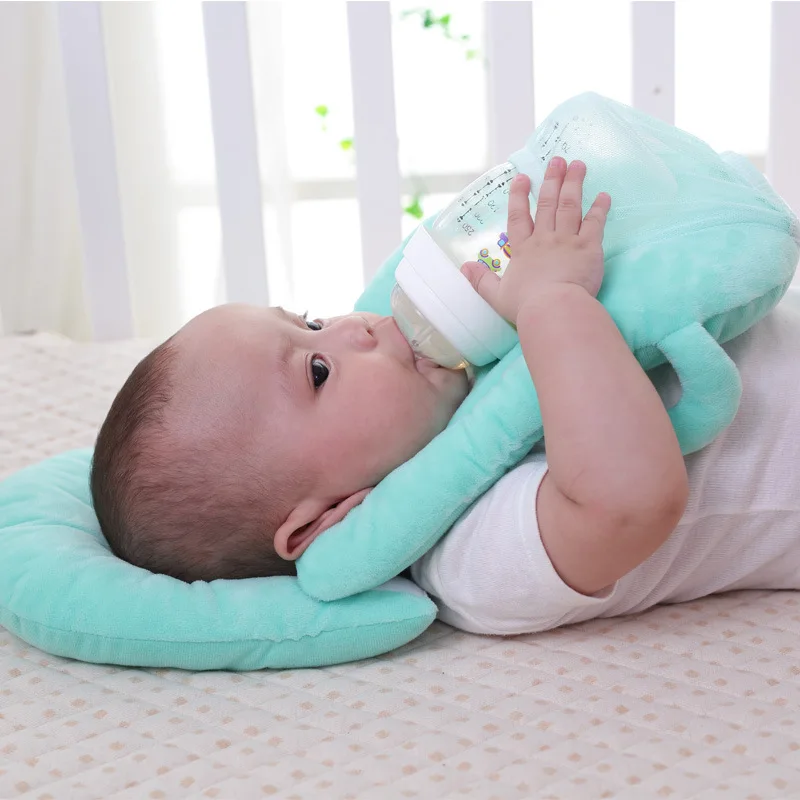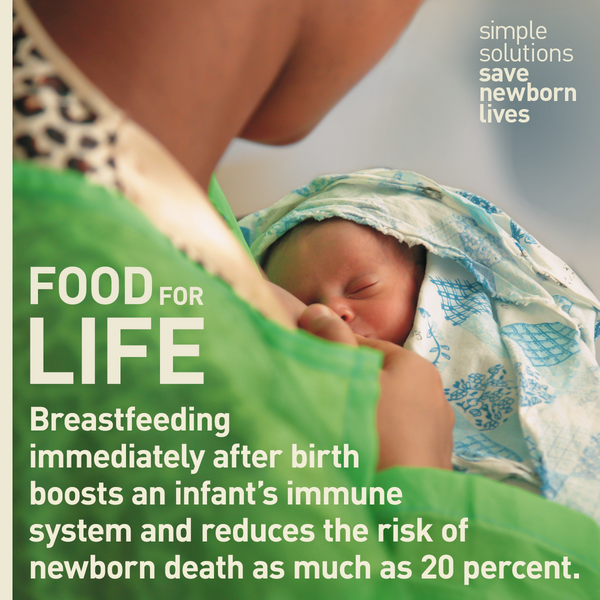What color foods to feed baby first
How to Start Introducing Solid Foods to Babies
Introducing solids to your baby can be intimidating. With safety and nutrition top of mind, we’d like to help simplify the introduction process. Starting on solid foods allows babies to get accustomed to eating, establish a feeding routine, learn about textures and experience using utensils. Our guide will help you transition your baby during their first year of life as they explore the diversity of solid foods.
Ready to start solids?
Prior to introducing solids, make sure your baby is developmentally ready. Consider the following readiness cues and benchmarks. Is your baby:
- Holding their head up without assistance?
- Sitting up without assistance?
- Propping up on their elbows while lying on their tummy?
- No longer sticking out their tongue automatically when something is put in their mouth (also called the “extrusion reflex”)?
- At least 4 months old?
When you’ve answered yes to these questions, and you’ve discussed starting solids with your pediatrician, we recommend introducing single ingredient purees. Don’t be surprised if your little one only eats a spoonful or two, as it can take a few days or even weeks before they learn to eat off a spoon. As you introduce solids, it is also important to remember that up until 12 months, babies should receive most of their nutritional needs from breast milk, formula or a combination of both.
What foods should I start with my baby?
Since babies are naturally inclined to prefer sweeter foods, it’s important to introduce vegetables prior to fruit in order to increase acceptance of more savory flavors. Additionally, when your baby starts eating, try one new puree every 2–3 days so your baby can get used to the new tastes and you can monitor for any allergic reactions.
Help your little one embark on their food journey by following these guidelines for choosing which purees to introduce.
Orange vegetables firstWhen first introducing solids, start with orange vegetable purees, like butternut squash, yam, sweet potato or pumpkin.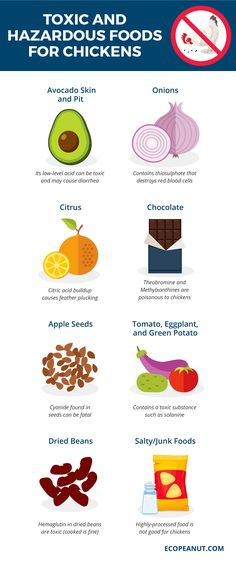 These offer a natural sweetness that tends to be easily accepted by babies. Increased acceptance can lead to an eager eater, so if your baby has a good first experience with foods, they’ll be more likely to try other purees later on.
These offer a natural sweetness that tends to be easily accepted by babies. Increased acceptance can lead to an eager eater, so if your baby has a good first experience with foods, they’ll be more likely to try other purees later on.
Once your baby accepts orange veggies, begin incorporating green veggie purees to their eating schedule while continuing to offer orange veggies. Green bean, pea and zucchini purees are a great place to start. These are slightly bitter in taste, which means your baby might need some help adjusting to these new flavors. If your baby is having difficulty accepting green veggies alone, try mixing in some of an orange veggie puree to add a little sweetness.
Finally…fruit!While your baby continues to enjoy orange and green veggies, slowly start introducing naturally sweet fruit. Fruit purees such as mango, apple, strawberry and pear are great single ingredient purees to start. Once your baby enjoys the sweetness of fruit, they may be less eager to enjoy veggies. Consider offering these less frequently or towards the end of the meal.
Consider offering these less frequently or towards the end of the meal.
Frequently asked questions about starting solids
1. Should I feed my baby rice cereal?In addition to fruits and vegetables, single iron-fortified grains like rice are a popular choice for first foods due to their bland taste, smooth texture and low allergen risk. Until they are about five to six months old, most babies have adequate iron stores acquired in-utero, so at six months, we recommend introducing foods that naturally contain dietary iron and pose a low allergy risk. Rather than traditional rice cereal, consider trying more fiber-filled, nutrient-dense grains or legumes such as buckwheat, millet, oatmeal, quinoa, beans or lentils.
2. What is the best way to introduce solids for the first time?When your baby is first starting solid food, it’s important to start mealtime when your baby is hungry and eager to eat. We recommend offering food before breast milk or formula is offered. Learn how to encourage interest in mealtime and exploration of new tastes in our full post on tips for introducing solids to your baby
Learn how to encourage interest in mealtime and exploration of new tastes in our full post on tips for introducing solids to your baby
We recommend starting with three meals per day, offering a few spoonfuls at each “meal” and progressing as your baby shows interest.
4. How can I prevent food allergies for my kid?According to the American Academy of Allergy Asthma & Immunology, allergists now recommend introducing certain foods as early as 4–6 months, which may reduce the potential of an allergen risk. Be sure to discuss introducing allergens with your pediatrician before starting solids. For more information on food allergies in children, check out our two part blog series with Dr. Steve Handoyo of the University of Chicago: Part 1, Part 2.
Starting solids with your baby is meant to be a time for food exploration and motor skill development. Remember that each baby is different and their starting solids experience will likely deviate from fellow babies’ experiences.
Remember that each baby is different and their starting solids experience will likely deviate from fellow babies’ experiences.
If you have questions or would like further guidance in designing the meal plan that is best for your child, feel free to contact our team at [email protected].
Introducing Solid Food To Baby By Color
Introducing Solid Food To Baby By Color | Prince LionheartSign up to receive 10% off your next purchase and get the scoop on upcoming promotions, giveaways and product launches.
Enter email address- Sep 30, 2020
There’s no one right way to introduce food to Baby. One fun method is to feed your baby by the colors of the rainbow. Feeding by color starts Baby on the path to enjoying a variety of healthy foods.
Benefits of Feeding By Color
As with all things parenting, you’ll hear different ideas about how to introduce solids to your baby. Some people start with feeding baby cereal by spoon and moving forward one puree at a time. Other people prefer baby led weaning, allowing babies to feed themselves with foods that are firm enough to grasp, but soft enough to be mashed with Baby's gums. Other people believe Baby should be able to eat anything at any time, as long as Baby won’t choke. There are no hard and fast rules about how to introduce food to Baby apart from making sure Baby is ready to get started with solids. The American Academy of Pediatrics (AAP) says there’s no medical evidence that there’s any advantage to introducing foods in any particular order. So, why not make it fun for you and Baby and feed by color? Go for it! Bravery is inside us all®.
Introducing solid food to Baby by color isn’t just fun, though. Feeding by color introduces your baby to different flavors, both savory and sweet. It also helps establish healthy eating habits while ensuring Baby gets all the nutrients they need to grow strong and healthy. Plus, it encourages kids to continue to be adventurous down the road by eating each color of the rainbow.
It also helps establish healthy eating habits while ensuring Baby gets all the nutrients they need to grow strong and healthy. Plus, it encourages kids to continue to be adventurous down the road by eating each color of the rainbow.
When to Start Baby Food
So, how do you know when to introduce baby food? The AAP has a few recommendations for when to start baby food with your baby. Generally speaking, babies are ready for solid food when they:
- Are 4 to 6 months old
- Weigh 13 lbs or more
- Doubled their birth weight
- Can sit up mostly on their own
- Hold their head up for a long time
- Show interest in solid food
- Open their mouth when food is nearby
- Get hungry between feedings
Babies usually let you know when to start baby food by showing interest in what you’re eating and grabbing for it. You may see Babies opening their mouths like baby birds whenever you eat. If you’re ready for introducing solid food to Baby, watch how they react to the food in their mouth.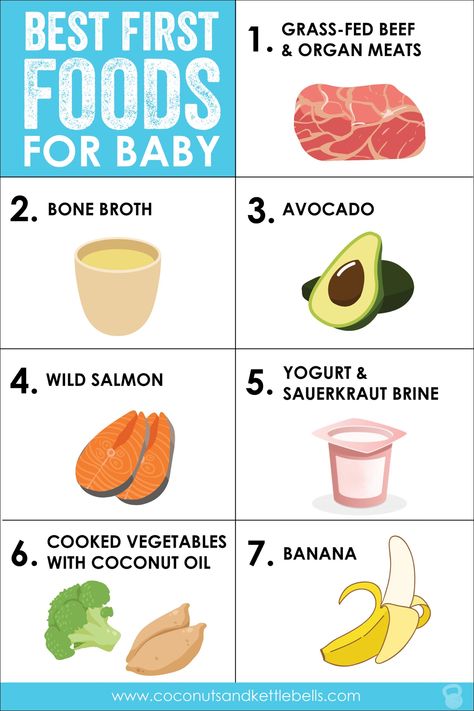 If Baby pushes the food out of their mouth with a tongue thrust, they’re not ready quite yet. Try again in a week or two. Look for Baby’s ability to move food to the back of their throat to swallow it. It may take a few tries since solids are a new experience for Baby, and the texture might take some getting used to for them. Once they’re able to swallow solid food, you’re ready to get the taste adventure started! Get your bibs and CATCHALL™ mat ready. Kids are messy. So is parenting®. (But your carpet doesn’t have to be!)
If Baby pushes the food out of their mouth with a tongue thrust, they’re not ready quite yet. Try again in a week or two. Look for Baby’s ability to move food to the back of their throat to swallow it. It may take a few tries since solids are a new experience for Baby, and the texture might take some getting used to for them. Once they’re able to swallow solid food, you’re ready to get the taste adventure started! Get your bibs and CATCHALL™ mat ready. Kids are messy. So is parenting®. (But your carpet doesn’t have to be!)
How to Introduce Food to Baby
Feeding by color is an exciting way to start introducing solid food to Baby! To get started, learn what each color of food can offer your baby in terms of nutrients and health benefits.
| Food Color | Nutrients & Health Benefits | Example Foods |
| Red/Pink | Sources of vitamin C, lycopene, and anti-inflammatory antioxidants. | Red peppers, beets, strawberries, cranberries, cherries, raspberries, watermelon, rhubarb, tomato |
| Orange | Sources of vitamin A, vitamin C, folate, beta-carotene, and potassium.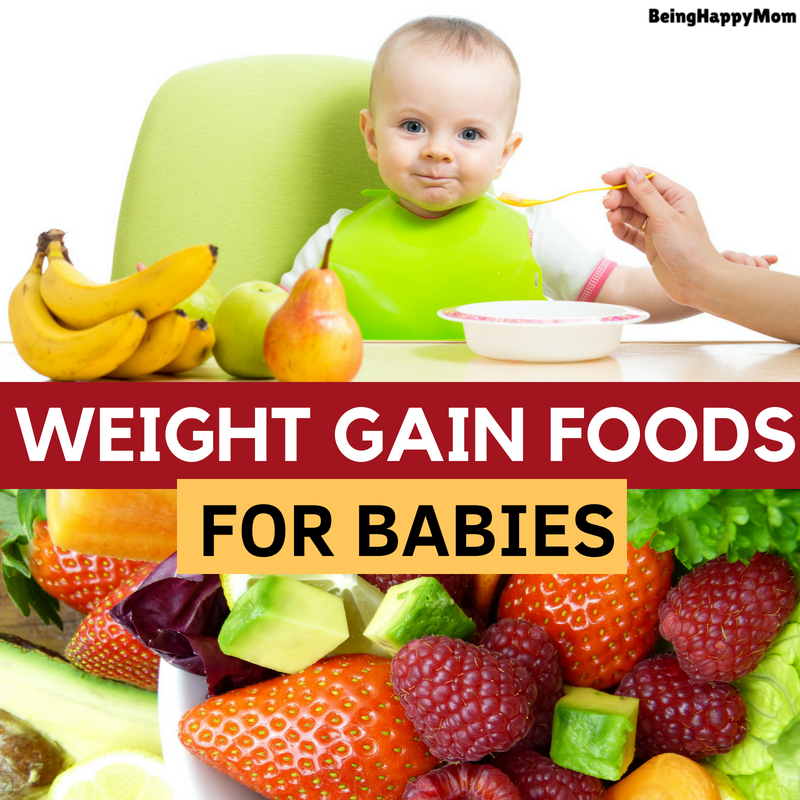 | Oranges, mango, orange peppers, papaya, cantaloupe, carrots, sweet potatoes, butternut squash |
| Yellow | Sources of vitamin C, vitamin B6, vitamin A, folic acid, potassium, and magnesium. | Bananas, yellow peppers, yellow beets, yellow apples, corn, yellow tomatoes, pears, summer squash |
| Green | Sources of lutein, folate, iron, vitamin K, vitamin D, vitamin A, vitamin C, calcium, potassium, magnesium, and amino acids. | Avocado, asparagus, broccoli, spinach, lettuce, kale, cabbage, edamame, peas, green beans, green peppers, zucchini, cucumber, green apple, honeydew, kiwi, lime |
| Blue/Purple | Sources of various antioxidants, but primarily anthocyanin, which protects your body against cell damage and inflammation. | Blueberries, blackberries, huckleberries, eggplant, figs, plums/prunes, red grapes/raisins, purple potatoes, purple carrots, purple cauliflower |
| White/Brown | Sources of vitamin C, magnesium, potassium, and selenium. | Cauliflower, mushrooms, white potato, turnips, parsnips, white pears, garbanzo beans |
Planning Baby’s menus is fun. Try looking at Baby’s diet over the course of the week, rather than per day. You’ll be hard-pressed to fit every color into a single day. In turn, it’s pretty easy to sprinkle them all in throughout a week. You can even do one color per day!
A week’s menu by color might look like this:
- Monday: Pureed red apple, pureed beets with baby cereal.
- Tuesday: Pureed butternut squash, pureed mango
- Wednesday: Mashed banana, pureed corn, flaked trout
- Thursday: Mashed avocado, pureed green peas
- Friday: Mashed plums, pureed purple cauliflower
- Saturday: Pureed garbanzo beans, mashed potato
- Sunday: Finely diced chicken, whatever’s left!
At first, solids are a supplement to breast milk or formula. A few months after starting solids, your baby should eat a wide variety of foods from each color category. Include veggies, fruits, proteins, and grains, as well as breast milk or formula until age one.
A few months after starting solids, your baby should eat a wide variety of foods from each color category. Include veggies, fruits, proteins, and grains, as well as breast milk or formula until age one.
With certain foods, it’s also a good idea to watch out for any adverse reactions, from diaper rashes to potential signs of a food allergy. According to the Centers for Disease Control and Prevention, the eight most common food allergies are to eggs, fish, milk, peanuts, shellfish, soy, tree nuts, and wheat, but other foods, like citrus, can cause diaper rash or a rash around the mouth because of their high acidity.
If there’s a history of food allergies in your family, watching out for allergic reactions is particularly important, so talk to your pediatrician before introducing any potential allergens and ask what to look out for in your baby. It may also be a good idea to wait 3-5 days between new foods to watch for any adverse reactions. Otherwise, feel free to give these foods a try!
If a food does cause a reaction in your baby, talk to your pediatrician about how to proceed. You may need to start with small tastes, or wait to reintroduce the food until later.
You may need to start with small tastes, or wait to reintroduce the food until later.
Important: Never give Baby honey until after the age of one because of the risk of botulism.
Tips For Feeding Baby
Now you know when to start baby food. Whether you begin with spoon feeding purees or letting Baby feed themselves from their CREATE™ Plate, offer lots of variety and see how Baby responds. Remember that kids’ preferences change. Stay flexible with Baby’s meal plan. Here a few tips for issues that might pop up.
What if Baby turns their head away or fusses when I offer more food?
Baby’s telling you they’re finished. Take it one bite at a time. Let them stop when they’re done.
What if Baby rejects a certain color of food?
Try a variety of foods in that color range. Even if Baby isn’t a fan of one green food, they might happily accept another. Alternately, take a break from that color and try again next week.
Can I protect my house/carpet from becoming rainbow colored?
Keep our CATCHALL™ mat under Baby’s chair to catch flying food. Put a big, absorbent bib on Baby before every feeding. Sit nearby and don’t put large containers within Baby’s reach. (Invest in a good stain remover, too.)
What if Baby gags on new foods?
If the texture is new, puree the food until it’s smoother, or strain out fibers. If it’s the flavor, take a break and try next week. Palates change.
← Back to Blogs
{{oneTimePuchaseText}} {{oneTimePuchaseAmount}}
{{subscribeText}}
$0.00
{{{deliveryFrequencyText}}} {{#multipleSellingPlan}}
{{#sellingPlanVariants}}
{{{sellingPlanDisplayText}}}
{{/sellingPlanVariants}}
{{/multipleSellingPlan}} {{^multipleSellingPlan}}
{{{singleSellingPlanDisplayText}}}
{{/multipleSellingPlan}}
{{#showStaticTooltip}}{{{toolTipDescription}}}
{{/showStaticTooltip}} {{^showStaticTooltip}}Subscription Details
{{{toolTipDescription}}}
{{companyName}}
{{/showStaticTooltip}} {% endraw %}`, "bundle": {}, "labels": "{\"appstle. subscription.wg.yearsFrequencyTextV2\":\"Years\",\"appstle.subscription.wg.weekFrequencyTextV2\":\"Week\",\"appstle.subscription.wg.oneTimePurchaseTextV2\":\"One Time Purchase\",\"appstle.subscription.wg.loyaltyPerkDescriptionTextV2\":\"\",\"appstle.subscription.wg.unsubscribeFrequencyTextV2\":\"unsubscribe\",\"appstle.subscription.wg.weeksFrequencyTextV2\":\"Weeks\",\"appstle.subscription.wg.oneTimeFrequencyTextV2\":\"One Time\",\"appstle.subscription.wg.dayFrequencyTextV2\":\"day\",\"appstle.subscription.wg.allowFulfilmentCountViaPropertiesV2\":\"false\",\"appstle.subscription.wg.monthsFrequencyTextV2\":\"Months\",\"appstle.subscription.wg.deliveryEveryFrequencyTextV2\":\"Delivery Every\",\"appstle.subscription.wg.subscribeAndSaveInitalV2\":\"Subscribe & save\",\"appstle.subscription.wg.offFrequencyTextV2\":\"Off\",\"appstle.subscription.wg.yearFrequencyTextV2\":\"Year\",\"appstle.subscription.wg.daysFrequencyTextV2\":\"Days\",\"appstle.subscription.wg.subscribeAndSaveSuccessV2\":\"Subscribe success\",\"appstle.
subscription.wg.yearsFrequencyTextV2\":\"Years\",\"appstle.subscription.wg.weekFrequencyTextV2\":\"Week\",\"appstle.subscription.wg.oneTimePurchaseTextV2\":\"One Time Purchase\",\"appstle.subscription.wg.loyaltyPerkDescriptionTextV2\":\"\",\"appstle.subscription.wg.unsubscribeFrequencyTextV2\":\"unsubscribe\",\"appstle.subscription.wg.weeksFrequencyTextV2\":\"Weeks\",\"appstle.subscription.wg.oneTimeFrequencyTextV2\":\"One Time\",\"appstle.subscription.wg.dayFrequencyTextV2\":\"day\",\"appstle.subscription.wg.allowFulfilmentCountViaPropertiesV2\":\"false\",\"appstle.subscription.wg.monthsFrequencyTextV2\":\"Months\",\"appstle.subscription.wg.deliveryEveryFrequencyTextV2\":\"Delivery Every\",\"appstle.subscription.wg.subscribeAndSaveInitalV2\":\"Subscribe & save\",\"appstle.subscription.wg.offFrequencyTextV2\":\"Off\",\"appstle.subscription.wg.yearFrequencyTextV2\":\"Year\",\"appstle.subscription.wg.daysFrequencyTextV2\":\"Days\",\"appstle.subscription.wg.subscribeAndSaveSuccessV2\":\"Subscribe success\",\"appstle. subscription.wg.monthFrequencyTextV2\":\"Month\",\"appstle.subscription.wg.selectDeliverOptionV2\":\"select deliver option\"}", "css": { "appstle_subscription_widget": { "margin-top": "" , "margin-bottom": "", }, "appstle_subscription_wrapper": { "border-width": "", "border-color": "", }, "appstle_circle": { "border-color": "", }, "appstle_dot": { "background-color": "", }, "appstle_select": { "padding-top": "", "padding-bottom": "", "padding-left": "", "padding-right": "", "border-width": "", "border-style": "", "border-color": "", "border-radius": "", }, "tooltip_subscription_svg": { "fill": "", }, "appstle_tooltip": { "color": "", "background-color": "", }, "appstle_tooltip_border_top_color": { "border-top-color": "", }, "appstle_subscription_final_price": { "color": "", }, "appstle_widget_text_color": { "color": "", }, "appstle_selected_background": { "background": "transparent", }, "customCSS": "", "customerPortalCss": "", } }; var _RSConfig = _RSConfig || {}; _RSConfig.
subscription.wg.monthFrequencyTextV2\":\"Month\",\"appstle.subscription.wg.selectDeliverOptionV2\":\"select deliver option\"}", "css": { "appstle_subscription_widget": { "margin-top": "" , "margin-bottom": "", }, "appstle_subscription_wrapper": { "border-width": "", "border-color": "", }, "appstle_circle": { "border-color": "", }, "appstle_dot": { "background-color": "", }, "appstle_select": { "padding-top": "", "padding-bottom": "", "padding-left": "", "padding-right": "", "border-width": "", "border-style": "", "border-color": "", "border-radius": "", }, "tooltip_subscription_svg": { "fill": "", }, "appstle_tooltip": { "color": "", "background-color": "", }, "appstle_tooltip_border_top_color": { "border-top-color": "", }, "appstle_subscription_final_price": { "color": "", }, "appstle_widget_text_color": { "color": "", }, "appstle_selected_background": { "background": "transparent", }, "customCSS": "", "customerPortalCss": "", } }; var _RSConfig = _RSConfig || {}; _RSConfig.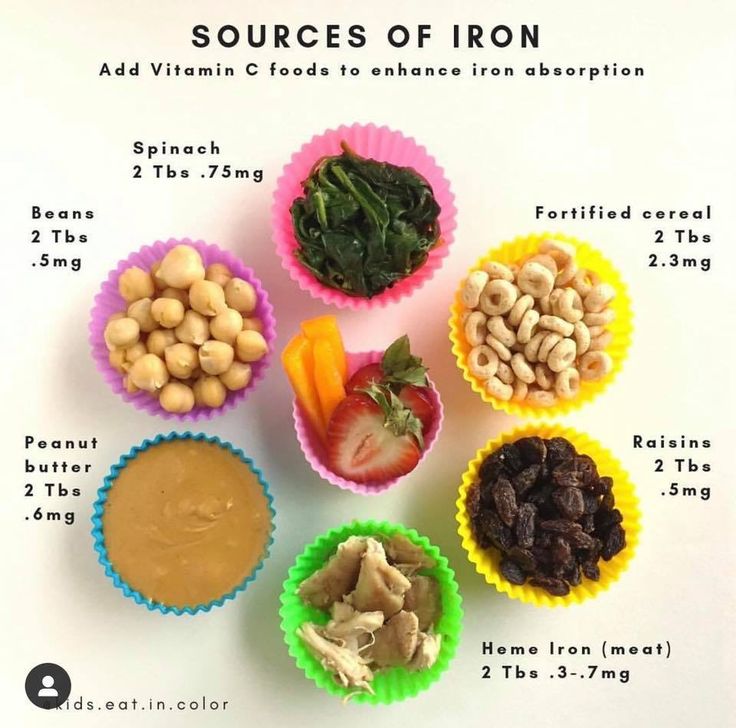 shop = 'prince-lionheart.myshopify.com'; _RSConfig.shopMoneyFormat = '${{amount}}'; _RSConfig.shopMoneyFormatWithCurrencyFormat = '${{amount}} USD'; }
shop = 'prince-lionheart.myshopify.com'; _RSConfig.shopMoneyFormat = '${{amount}}'; _RSConfig.shopMoneyFormatWithCurrencyFormat = '${{amount}} USD'; } Diet for a child aged 4
Your baby is already 4 months old. He has noticeably grown up, become more active, is interested in objects that fall into his field of vision, carefully examines and reaches for them. The emotional reactions of the child have become much richer: he joyfully smiles at all the people whom he often sees more and more often, makes various sounds.
Are you still breastfeeding or have you switched to formula or formula feeding? The child is actively growing, and only with breast milk or infant formula, he can no longer always get all the necessary nutrients. And that means it's time to think about complementary foods.
Optimal time to start its introduction is between 4 and 6 months, regardless of whether the baby is receiving breast milk or formula. This is the time when children respond best to new foods. Up to 4 months, the child is not yet ready to perceive and digest any other food. And with the late introduction of complementary foods - after 6 months, children already have significant deficiencies of individual nutrients and, first of all, micronutrients (minerals, vitamins, long-chain polyunsaturated fatty acids, etc.). In addition, toddlers at this age often refuse new foods, they have delayed development of chewing skills for thick foods, and inadequate eating habits are formed. It is important to know that, no matter how strange it may seem at first glance, with a delayed appointment of complementary foods, allergic reactions more often occur on them.
This is the time when children respond best to new foods. Up to 4 months, the child is not yet ready to perceive and digest any other food. And with the late introduction of complementary foods - after 6 months, children already have significant deficiencies of individual nutrients and, first of all, micronutrients (minerals, vitamins, long-chain polyunsaturated fatty acids, etc.). In addition, toddlers at this age often refuse new foods, they have delayed development of chewing skills for thick foods, and inadequate eating habits are formed. It is important to know that, no matter how strange it may seem at first glance, with a delayed appointment of complementary foods, allergic reactions more often occur on them.
When is it advisable to introduce complementary foods as early as 4 months, and when can you wait until 5.5 or even 6 months? To resolve this issue, be sure to consult a pediatrician.
The optimal time to start introducing complementary foods to a healthy baby is between 5 and 5.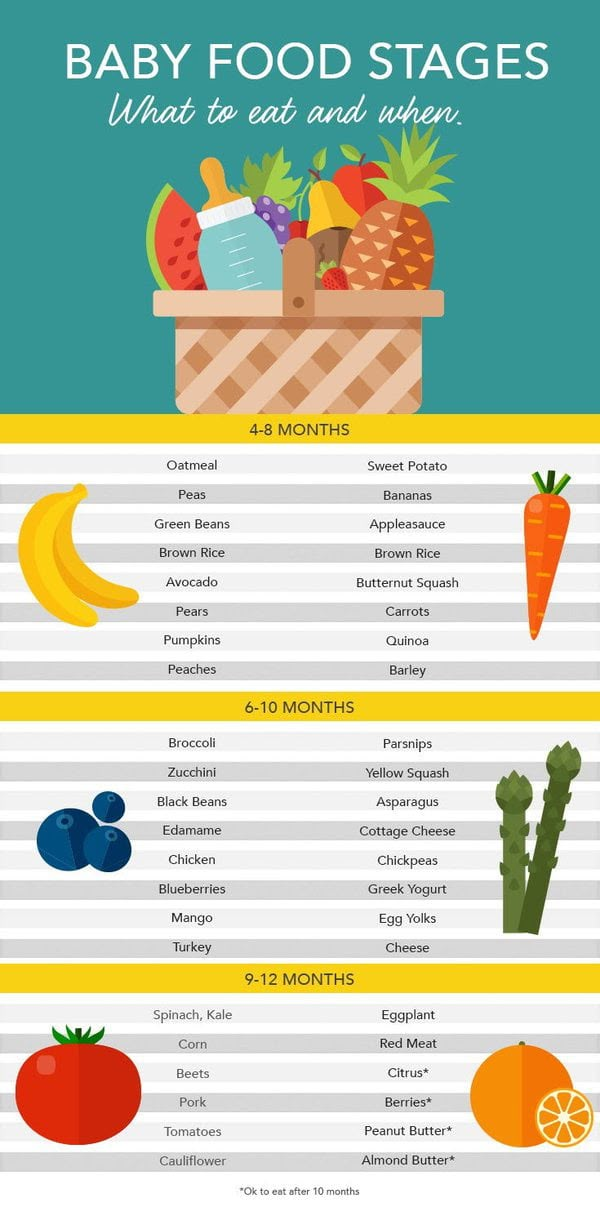 5 months of age.
5 months of age.
The World Health Organization recommends that breastfed babies should be introduced to complementary foods from 6 months of age. From the point of view of domestic pediatricians, which is based on the big
practical experience and scientific research, this is possible only in cases where the child was born at term, without malnutrition (because in these cases the mineral reserves are very small), he is healthy, grows and develops well. In addition, the mother should also be healthy, eat well and use either specialized enriched foods for pregnant and lactating women, or vitamin and mineral complexes in courses. Such restrictions are associated with the depletion of iron stores even in a completely healthy child by 5-5.5 months of age and a significant increase in the risk of anemia in the absence of complementary foods rich or fortified with iron. There are other deficits as well.
The first food product can be vegetable puree or porridge, it is better to give fruit puree to the baby later - after tasty sweet fruits, children usually eat vegetable puree and cereals worse, often refuse them altogether.
Where is the best place to start? In cases where the child has a tendency to constipation or he puts on weight too quickly, preference should be given to vegetables. With a high probability of developing anemia, unstable stools and small weight gains - from baby cereals enriched with micronutrients. And if you started introducing complementary foods with cereals, then the second product will be vegetables and vice versa.
If the first complementary foods are introduced at 6 months, it must be baby porridge enriched with iron and other minerals and vitamins, the intake of which with breast milk is no longer enough.
Another important complementary food product is mashed meat. It contains iron, which is easily absorbed. And adding meat to vegetables improves the absorption of iron from them. It is advisable to introduce meat puree to a child at the age of 6 months. Only the daily use of children's enriched porridge and meat puree can satisfy the needs of babies in iron, zinc and other micronutrients.
But it is better to introduce juices later, when the child already receives the main complementary foods - vegetables, cereals, meat and fruits. After all, complementary foods are needed so that the baby receives all the substances necessary for growth and development, and there are very few in their juices, including vitamins and minerals.
Juices should not be given between feedings, but after the child has eaten porridge or vegetables with meat puree, as well as for an afternoon snack. The habit of drinking juice between meals leads to frequent snacking in the future, a love of sweets is instilled, children have more tooth decay and an increased risk of obesity.
With the start of the introduction of complementary foods, the child is gradually transferred to the 5-time feeding regimen.
Complementary feeding rules:
- preference should be given to baby products of industrial production, they are made from environmentally friendly raw materials, have a guaranteed composition and degree of grinding
- Complementary foods should be offered to the baby by spoon at the start of feeding, before breastfeeding (formula feeding)
- the volume of the product increases gradually, starting with ½ - 1 spoon, and in 7 - 10 days we bring it to the age norm, subsequent products within the same group (cereals from other cereals or new vegetables) can be introduced faster, in 5 - 7 days
- start introduction with monocomponent products
- it is undesirable to give a new product in the afternoon, it is important to follow how the child reacts to it
- do not introduce new products in the event of acute illnesses, and before and immediately after prophylactic vaccination (should be abstained for several days)
When introducing a new type of complementary food, first try one product, gradually increasing its amount, and then gradually "dilute" this product with a new one.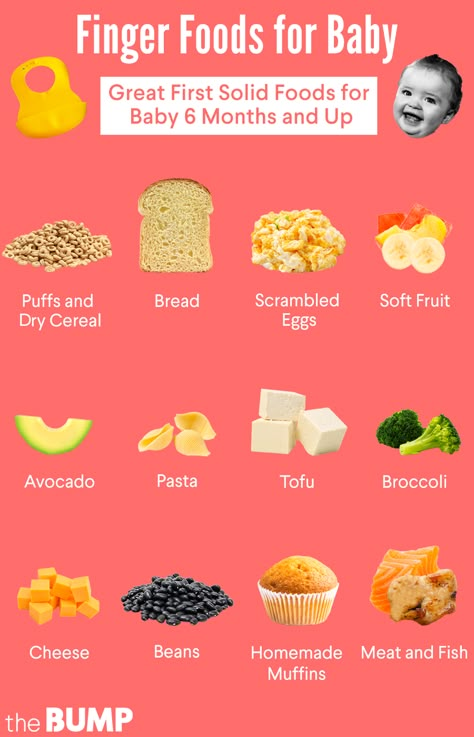 For example, vegetable complementary foods can be started with a teaspoon of zucchini puree. During the week, give the baby only this product, gradually increasing its volume. After a week, add a teaspoon of mashed broccoli or cauliflower to the zucchini puree and continue to increase the total volume every day. Vegetable puree from three types of vegetables will be optimal. The portion should correspond to the age norm. Over time, you can replace the introduced vegetables with others faster.
For example, vegetable complementary foods can be started with a teaspoon of zucchini puree. During the week, give the baby only this product, gradually increasing its volume. After a week, add a teaspoon of mashed broccoli or cauliflower to the zucchini puree and continue to increase the total volume every day. Vegetable puree from three types of vegetables will be optimal. The portion should correspond to the age norm. Over time, you can replace the introduced vegetables with others faster.
After the introduction of one vegetable (bringing its volume to the required amount), you can proceed to the intake of porridge, and diversify the vegetable diet later.
If the child did not like the dish, for example, broccoli, do not give up on your plan and continue to offer this vegetable in a small amount - 1-2 spoons daily, you can not even once, but 2-3 times before meals, and after 7 - 10, and sometimes 15 days, the baby will get used to the new taste. This diversifies the diet, will help to form the right taste habits in the baby.
Spoon-feed with patience and care. Forced feeding is unacceptable!
In the diet of healthy children, porridge is usually introduced after vegetables (with the exception of healthy breastfed children, when complementary foods are introduced from 6 months). It is better to start with dairy-free gluten-free cereals - buckwheat, corn, rice. At the same time, it is important to use porridge for baby food of industrial production, which contains a complex of vitamins and minerals. In addition, it is already ready for use, you just need to dilute it with breast milk or the mixture that the baby receives.
Children suffering from food allergies are introduced complementary foods at 5-5.5 months. The rules for the introduction of products are the same as for healthy children, in all cases it is introduced slowly and begins with hypoallergenic products. Be sure to take into account individual tolerance. The difference is only in the correction of the diet, taking into account the identified allergens. From meat products, preference should first be given to mashed turkey and rabbit.
Diets for different age periods
explain how to make a diet, it is better on several examples that will help to navigate the menu for your child.
From 5 months, the volume of one feeding is on average 200 ml.
Option 1.
I feeding
6 hours
Breast milk or VHI*
200 ml
II feeding
10 hours
Dairy-free porridge**
Supplementation with breast milk or VHI*
150 g
50 ml
III feeding
14 hours
Vegetable puree
Meat puree Vegetable oil
Supplemental breast milk or VHI*
150 g
5 - 30 g
1 tsp
30 ml
IV feeding
18 hours
Fruit puree
Breast milk or VHI*
60 g
140 ml
V feeding
22 hours
Breast milk or VHI*
200 ml
* - Children's dairy mixture (VHI)
** - diluted with breast milk or VHI
Option 2.
9000 9000 9000 9000 9000 9000 9000 9000 9000 9000 9000 9000 9000 9000 9000 9000 9000 9000 9000 9000 9000 9000 9000 9000 9000 9000
baby 6 months, if complementary foods were introduced from 4 - 5 months:
| I feeding | Breast milk or VHI* | 200 ml |
| II feeding | Dairy-free porridge** | 150 g |
| III feeding | Vegetable puree | 150 g |
| IV feeding | Fruit puree | 40 g |
| V feeding | Breast milk or VHI* | 200 ml |
* - Children's dairy mixture
** - diluted with breast milk or DMS
Option 3.
An approximate daily diet for a baby at 6.5 months on breastfeeding, if complementary foods began to be administered from 6 months:
| I feeding | Breast milk | |
| II feeding | Dairy-free porridge** | 100 g |
| III feeding | Vegetable puree | 100 g |
| IV feeding | Breast milk |
|
| V feeding | Breast milk |
|
** - diluted with breast milk
Up to 7 months, increase the volume of porridge and vegetable puree to 150 g and introduce fruit puree.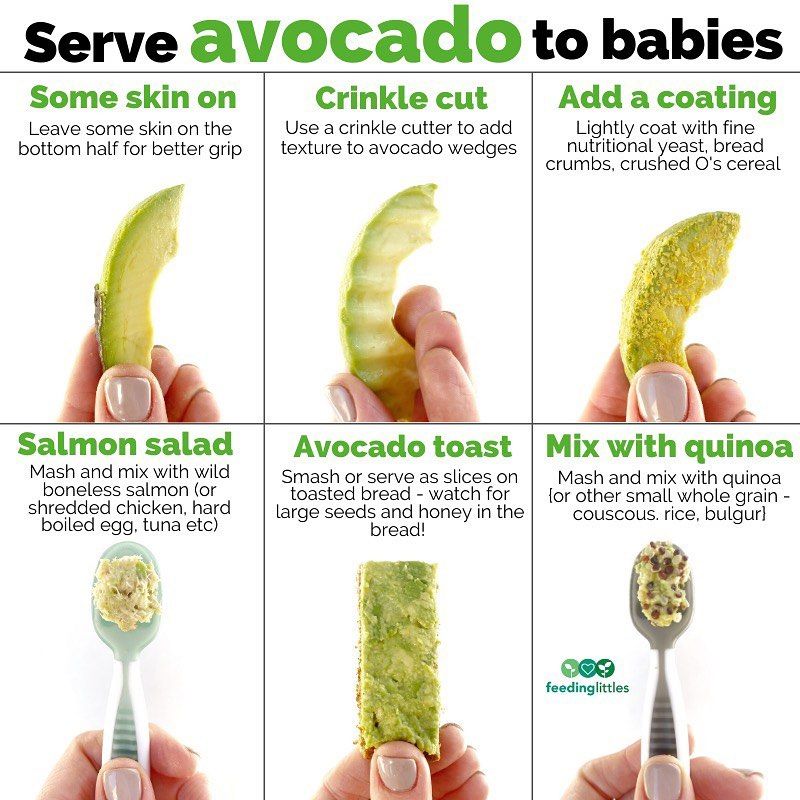
Complementary feeding rules + BONUS (approximate diet for a child up to a year from a dietitian)
116871
From six months, or maybe even earlier, your baby is already ready to try adult food. Where to start, what absolutely should not be done, and how to convince the "unwilling" to try a new product? Nutritionist Maria Litvinova answers mothers' questions, and mothers share their secrets.
From personal experience
In matters of nutrition, I act more intuitively ( leading heading experience - note. ). Our little one, now 9 months old, has been interested in adult food since about 5 months old. By this time, his first teeth had already appeared, so from 5.5 months the pediatrician allowed him to start complementary foods.
Since we are very large and breastfeeding, the first began to introduce vegetable puree, and then fruit puree, a quarter of a teaspoon. Portions increased gradually, a new product came about once every 5-6 days.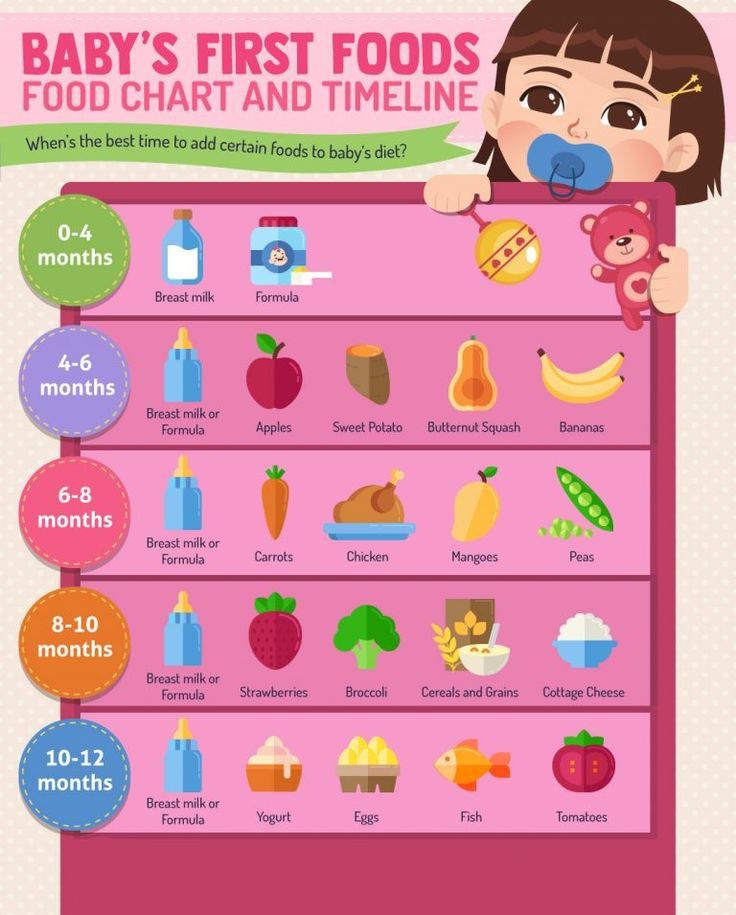 There was no particular enthusiasm, and carrots, broccoli, pears caused a clear disgust. Leaders - apple, plum. In the same period, they began to give a little seasonal fruit in a nibbler and a banana scraped with a spoon. Vegetables were better in the form of a thin soup with a slight addition of sunflower oil. Closer to 6.5–7 months, we got acquainted with meat: turkey, rabbit, then other types. Meat, both jarred and fresh, chopped in a blender, I liked even less. After 7 months, dairy-free cereals began. I liked rice, oatmeal, corn, less - buckwheat. After some time, they began to add a little butter to it, and after 8 months they switched to milk porridge. Monocomponent ones go well, but the test of the multicomponent one with berries was not successful: the cheeks and ears turned red. In the same period, fruit purees with cottage cheese, and then with cream, began to be eaten with pleasure. Sometimes the baby agrees to chew baby biscuits slightly soaked in water. We don’t like chicken yolk and are easily recognized in other foods, so we don’t eat it regularly.
There was no particular enthusiasm, and carrots, broccoli, pears caused a clear disgust. Leaders - apple, plum. In the same period, they began to give a little seasonal fruit in a nibbler and a banana scraped with a spoon. Vegetables were better in the form of a thin soup with a slight addition of sunflower oil. Closer to 6.5–7 months, we got acquainted with meat: turkey, rabbit, then other types. Meat, both jarred and fresh, chopped in a blender, I liked even less. After 7 months, dairy-free cereals began. I liked rice, oatmeal, corn, less - buckwheat. After some time, they began to add a little butter to it, and after 8 months they switched to milk porridge. Monocomponent ones go well, but the test of the multicomponent one with berries was not successful: the cheeks and ears turned red. In the same period, fruit purees with cottage cheese, and then with cream, began to be eaten with pleasure. Sometimes the baby agrees to chew baby biscuits slightly soaked in water. We don’t like chicken yolk and are easily recognized in other foods, so we don’t eat it regularly. During the day, the baby drinks a little water, occasionally - highly diluted juice. After 9months, we began to gradually introduce children's yogurt, we plan to try children's kefir. In cases where the child is stubborn, co-feeding with one of their favorite toys helps, but sometimes. Otherwise, the meal is transferred, or the portion is divided into two parts.
During the day, the baby drinks a little water, occasionally - highly diluted juice. After 9months, we began to gradually introduce children's yogurt, we plan to try children's kefir. In cases where the child is stubborn, co-feeding with one of their favorite toys helps, but sometimes. Otherwise, the meal is transferred, or the portion is divided into two parts.
For information . WHO suggests the following rates of increase in complementary foods: if started at 6 months, other foods together with fluids should make up approximately 25% (150 - 250 g) of the total diet by 1 year - in the event that the baby is breastfed , and he requires breasts regardless of meals . In artificial children, ordinary food quickly replaces formula feedings, one by one, all meals are successively replaced. A child's introduction to complementary foods can take up to a year.
Tatyana G. , mother of many children:
, mother of many children:
– No complementary foods until six months, only filtered water, if it's hot. The introduction of complementary foods began with vegetables, then cereals, meat. I introduced fruits when teeth appeared . I introduced sour milk to my daughter immediately after cereals, the boys are allergic to preservatives, so only after a year and a half. The peasants did not want complementary foods until almost 9 months. I don't give any sweets, juices, chocolate, even cookies to the younger ones. They don’t even ask, t and to as they don’t know. In the handle a crust of bread, cucumber, dried fruit.
Tatyana D., mother of many children:
- I am against canned puree, I cooked it myself. But she didn't really force it. At least while breastfeeding. Later she gave a cucumber, a crust of bread in her hand - they got used to chewing it. Drank juices, fresh juices, fresh compotes.
Basic rules for the introduction of complementary foods
According to the nutritionist Maria Litvinova , the introduction of complementary foods is a crucial stage in a child's life. Its main goal is to provide the growing body with the nutrients necessary for development. A child who is breastfed does not need to introduce additional food products up to 6 months of life.
Rule 1. Complementary feeding age
Usually 6 months is the average time to start complementary foods. With insufficient weight gain, it can be recommended earlier: at 4.5 months - for a child on artificial feeding, at 5 months - for breastfeeding. Ideally, if the baby has at least 1 tooth at the beginning of the introduction of complementary foods, the child explores the contents of mom and dad's plates with interest, the baby is healthy and has not received preventive vaccinations in the last 3 days. However, the fundamental principle of rational nutrition of infants is maximum individualization and taking into account the characteristics of the state of health.
Rule 2. Type of complementary foods
In case of underweight, frequent stools the optimal first complementary food is porridge . With overweight, constipation, signs of rickets - vegetable puree. Then enter meat , later porridge.
Complementary feeding algorithm:
- complementary foods are given at the beginning of feeding, gradually replacing breast milk or an adapted formula ;
- when switching to a fundamentally new type of complementary foods (vegetable, cereal or sour milk), you should start with half a teaspoon, bringing the serving volume to the recommended norm in 2 weeks
- Complementary foods should be free of chunks in texture and should not cause difficulty in swallowing ;
- each new product is introduced within 5 days with obligatory monitoring of the reaction, including the appearance of a rash, a change in the nature of the stool ;
- new products introducing yat into the child's diet in the first half of the day, so that the reaction can be traced until the evening.

First food "Vegetables + meat" (6 months)
The first vegetable product is usually zucchini, you can add cauliflower puree or broccoli. Then, multicomponent purees are introduced at the expense of pumpkin, cabbage, and subsequently - tomatoes and beets. From 7 months green peas are added.
5 grams of vegetable oil can be added when the volume of the main serving of vegetable puree is half of what it should be. Meat in the form of minced meat or mashed potatoes is added to vegetables in an amount of up to 50 grams per day ( this combination allows the absorption of iron ). The age of introduction is 7 months.
Up to 9-10 months it is better to use special canned meat for children.
The second complementary foods - porridge (7-8 months)
It is better to introduce the first porridge with buckwheat - one of the most useful in terms of vitamin and mineral composition. Then rice, oatmeal, millet, wheat, corn porridge. Semolina porridge is not introduced until a year old, but it is better to wait up to three years (semolina porridge has a high glycemic index, and it also prevents the absorption of calcium).
Semolina porridge is not introduced until a year old, but it is better to wait up to three years (semolina porridge has a high glycemic index, and it also prevents the absorption of calcium).
Later, porridge can be prepared with milk formula (50 ml water + 50 ml formula). Cow's milk should not be used before the age of one. Butter in the amount of 5 grams is added to porridge when the volume of porridge injected is at least 70 ml.
By 9-10 months, multi-cereal porridges are introduced, as well as baby pasta.
Third food - fruit purees (7-8 months)
Fruit should be introduced after vegetables. It is better to use seasonal berries and fruits. In summer - apple, pears, currants, gooseberries and even strawberries. In winter - industrial mashed potatoes. Fruits can be consumed separately, or with cereals, preferably dairy-free.
Fruit juices are undesirable for children, especially industrial ones, as they contain a lot of sugar. It is better to teach a child to drink water, you can give dried fruit compotes, fresh juices diluted by half with water. Herbal teas should not be given without a doctor's recommendation.
Herbal teas should not be given without a doctor's recommendation.
Cottage cheese is recommended from 6 months, but it is better to introduce it later, because. the baby is getting enough breast milk or formula. Up to a year, use only special children's curds. This will reduce the risk of stress on the kidneys. After a year, cottage cheese can be given plain, raw or in the form of casseroles. Dairy products are tried at 8 months. They should not exceed 200 ml per day.
Fish and offal introduced from 8 months. From 8–9 months, fish is offered once or twice a week instead of meat. The yolk begins to be introduced from 7 months (bring to the norm 1/4 - ½ of the yolk). Crackers, cookies - from 7 months.
From 8 months you can use onions and garlic, from 9 months you can use spices (white pepper, bay leaf) and spicy vegetables (celery, dill).
Approximate diet for a child under one year old:
| Age | 6.00 | 10.00 | 14. 00 00 | 18.00 | 22.00 |
| 6 months | Breast milk or formula - 200 ml. | Breast milk or formula - 200 ml. | Vegetable puree 150 g Vegetable oil 1 tsp. Breast milk or formula - 50 ml. (meat puree - 30 g with the introduction of meat). | Breast milk or formula - 200 ml. | Breast milk or formula - 200 ml. |
| 7 months | Breast milk or formula - 200 ml. | Porridge - 150-170 g Fruit puree - 30 g Yolk - 1/4 | Vegetable puree 160 g Vegetable oil 1 tsp Meat puree - 50 g Bread - 5 g | Breast milk or formula - 130 ml Fruit puree - 40 g biscuits - 5 g. | Breast milk or formula - 200 ml. |
| 8 months | Breast milk or formula - 200 ml. | Porridge – 170 g Fruit puree – 30 g Yolk – 1/2 | Vegetable puree 180 g Vegetable oil 1 tsp Meat (fish) puree – 50 g Bread – 5 g | Breast milk or formula - 110 ml Fruit puree - 40 g Cottage cheese - 40 g Cookies - 10 g | Breast milk or kefir - 200 ml. |
| 9-10 months | Breast milk or formula - 200 ml. | Porridge – 180 g Fruit puree – 50 g Yolk – 1/2 | Vegetable puree 180 g Vegetable oil 1 tsp Meat (fish) puree – 50 g Bread – 5 g | Breast milk or kefir – 100 ml Fruit puree – 50 g Cottage cheese – 40 g Cookies – 10 g | Breast milk or kefir - 200 ml. |
| 11-12 months | Breast milk or formula - 200 Porridge - 200 ml. | Porridge - 180 g Fruit puree - 50 g Yolk - 1/2 | Breast milk or kefir - 150 ml. Meat (fish) puree - 70 g Vegetable puree 180 g. Vegetable oil 1 tsp. Bread - 5 g | Fruit puree - 60 g Breast milk or kefir - 200 ml. Cottage cheese - 40-60 g biscuits - 10-15 g | Breast milk or kefir - 200 ml. |
* The table shows an example menu. Porridge can be cooked on a mixture or breast milk - the volumes are indicated with this in mind. Kefir or mixture is written everywhere. Depends on the preferences of the child, can be mutually replaced. Kefir is enough once a day.
Kefir is enough once a day.
Feed the baby, mission impossible?
Elena F., a young mother:
– There was no way to feed the elder. They invented everything they could: they fed their favorite toys with him, and read books at the table, and watched TV, and all kitchen utensils were used in turn. And my grandmother was both a clown and a man-orchestra.
Many mothers have problems feeding their little “unwanted babies”. Accumulating numerous Internet tips and recommendations of familiar mothers, I would venture to offer a few recommendations:
It is better to feed from bright dishes.- The child should eat only at the table, sitting in his chair, and not in a random place, and preferably at least once a day with the whole family. And start complementary foods, only noticing its complete readiness: it is the desire to try food, and not play with dishes and napkins. Everything is very individual, and the child does not owe anything to anyone,
- It’s good to have a separate bright dish that will be associated exclusively with food, and to instill independent nutrition skills as early as possible.
 in special devices, like a nibbler, or scrape with a spoon. Then you should give them as often as possible. The child must have free access to them during the day,
in special devices, like a nibbler, or scrape with a spoon. Then you should give them as often as possible. The child must have free access to them during the day,
- Snacks should not be allowed between meals, sweets and pastries should not be given,
- Sweets, soda, fast food should be introduced to the baby as late as possible, 2-3, as is customary, and make a verdict - they say, "he categorically does not eat this with us";
- Disliked foods should be masked with preferred ones. Meat and yolk are better combined with vegetables than porridge,
- Never turn food into a game, feed after cartoons, advertising,
- Food should not become either a source of encouragement or punishment;
- It is worth showing patience, not pushing the child. He may finish eating later or even skip feedings entirely. The daily norm of the product can be divided into two doses;
- A child has every right not to adhere to the norms of nutrition, and to eat according to his appetite: today a lot, and tomorrow a little bit.
 Do not force to eat;
Do not force to eat;
- For older people who don't want to, you can make a dish unusual and beautiful. Hide a useful edible surprise in it. Take ideas from Jacob's Food Diaries blog here;
- You can try to cheat: put a plate of food in front of you so that the child seems to be eating your food. Although most sources advise teaching a child to eat only from his own plate;
- The whole family should demonstrate proper eating behavior: eat slowly, with appetite, the right foods. Emphasize the pleasure of the process;
- Sometimes you can use your imagination: for example, there was a suggestion for children over one year old to put an album and a felt-tip pen next to the plate. If a child eats a pear, shade a piece of the drawn one with each piece, the same with soup;
- Food should always be at a comfortable temperature, portions should be small, and the menu varied;
- Avoid allergenic foods if there is a tendency in the family.





